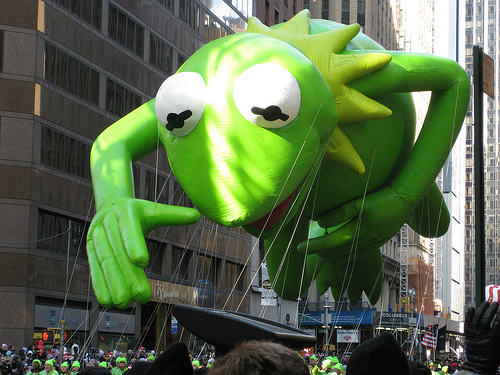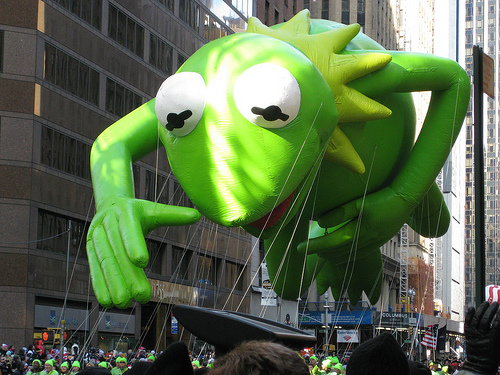Send your question to Umbra!
Q. Dear Umbra,
Whenever I read the word “green” in quotation marks, I get the same sensation as when I hear nails on a chalkboard. Can you help me understand how this practice came about and what differentiates something as being “green” vs. just plain old green (sans quotation marks)?
Looking forward to getting to the bottom of my visceral reaction to the use of “green.”
Thanks!
Kathy
Philadelphia
A. Dearest Kathy,
 Eh, it’s not so hard being green.Photo: Ben+Sam via FlickrI have the same reaction when people use the word “edgy,” as in, “How can we make this headline, photo, story lead, interview question. etc. more edgy?” It makes me want to bludgeon my ears with my computer mouse.
Eh, it’s not so hard being green.Photo: Ben+Sam via FlickrI have the same reaction when people use the word “edgy,” as in, “How can we make this headline, photo, story lead, interview question. etc. more edgy?” It makes me want to bludgeon my ears with my computer mouse.
So how did this whole “green” labeling get started? It looks like “green” was originally coined as a political term by Die Grünen, the first successful Green Party in the late ’70s. (Grün means green in German.) Methinks the word green, as a symbol of nature, trees, and renewal, represented the exact opposite of all the things the Green Party opposed, like pollution and other not-so-nice side effects of a highly industrialized society. Et voila. Green (or “green”) was born.
However, since then, as you point out, the term has been appropriated to sell body wash, ground beef, cat food, baby clothes, and myriad other allegedly eco-friendly products, services, ideas, places, and causes that may or may not actually have anything to do with the environmental movement. Since “green” isn’t a regulated term, it’s become essentially meaningless.
In fact, your letter has me feeling motivated. What do you say we start ourselves a counter campaign? We need a slogan: Say no to green? Green means stop? OK, we’ll keep mulling. Bottom line is the word—not to be confused with the color—”green” has officially jumped the shark. So what to do?
The thing is, you can’t just declare a product or place or business or person “eco” or “green” or “environmentally friendly.” The proof is in the pudding. Actions speak—nay, shout—louder than words. Especially meaningless words like green.
So here’s my advice: When you hear something referred to as green, take it with a hefty grain of salt and perform the diligence necessary to find out what’s actually “green” about it.
How to deal with the nails on a chalkboard feeling? Try this: Treat “green” like today’s secret word from Pee-wee’s Playhouse, and whenever you hear it simply follow Pee-wee’s advice: “For the rest of the day, whenever anybody says the secret word, scream real loud!” At the very least, it should be a good way to blow off some steam.
Hey, how about: Not green, just good? Who’s with me?
Vertly,
Umbra
I have been trying to find a recipe for homemade laundry detergent that is easy on the environment and nontoxic, and I noticed a lot of recipes call for borax. Since it is often recommended as a “green” cleaning product, I’ve tried a little research, but I can’t find a definitive answer. Is borax toxic? Is it biodegradable? Is it safe to use in the laundry? Are there better alternatives to make an effective laundry detergent that is friendly for both people and the environment?
Kym
Newington, Conn.
A. Dearest Kym,
Here we go again with that whole “green” thing. Well, working off our new Not green, just good slogan, Borax is a mixed bag, my friend. On the one hand, it is a naturally derived cleaning agent, but it does have to be mined and can be toxic in large doses. However, it is indeed the lesser of two evils, with conventional detergent being the one with the devil horns.
Luckily, I found a recipe for laundry detergent that uses water, baking soda, and castile soap—all A-OK in my book—instead of borax.
I’ve previously delved into the world of what to look for (or rather look out for) when buying instead of DIY-ing your laundry detergent. But if you’re looking for a readymade alternative to those alternatives, there’s the wonderful world of soapnuts, the dried fruit of the Chinese soapberry tree, which contains the natural cleaning agent saporin. My soapnutty friends totally swear by them. But I’m sticking with my tried-and-true castile soap and baking soda combo.
Spin cycle-ly,
Umbra
Q. Dear Umbra,
You asked computer nerds about battery charging. While technology has improved over the years, batteries are still considered consumables. In short, the rechargeable batteries in our devices only have a certain number of charges. These do not use time to determine lifespan, but rather how many times you have charged. While newer batteries don’t technically require conditioning, some still like to completely drain theirs before charging. This used to help increase the amount of time you could run off battery, but on these newer devices, the jury is still out.
These newer batteries have improved to the point that some companies like Apple have made their newest devices include nonremovable batteries, so secure are they in the knowledge that the battery will now outlive the device.
I write this on my iPad, which really does get 8–10 hours-plus on a single charge. Very nice.
Thanks!
Heather G.
Mountain View, Calif.
A. Dearest Heather,
Thank you, my computer nerd sister! I’m really more of a book nerd myself; but whatever. We nerds have to stick together.
And thank you all for your generous words of wisdom on all the topics I cover from nuclear power to pet toys. I hope you’ll be up for contributing your thoughts on our food system for the book club discussion on Diet for a Hot Planet: The Climate Crisis at the End of Your Fork and What You Can Do About It by Anna Lappé, who will be kicking things off with a live chat at 11 a.m. PDT Tuesday (that’s tomorrow!). Get your burning questions ready!
Chattily,
Umbra


